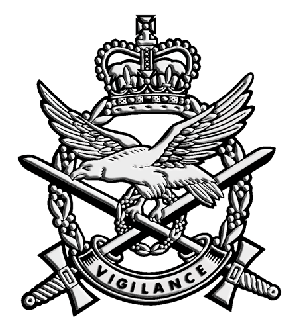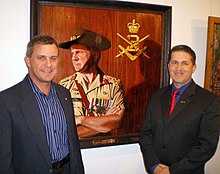
The Netherlands Armed Forces are the military services of the Kingdom of the Netherlands. The core of the armed forces consists of the four service branches: the Royal Netherlands Navy, the Royal Netherlands Army, the Royal Netherlands Air Force and the Royal Netherlands Marechaussee. The service branches are supplemented by various joint support organisations. In addition, local conscript forces exist on the Dutch Caribbean islands of Aruba (AruMil) and Curaçao (CurMil). These operate under the auspices of the Royal Netherlands Navy and the Netherlands Marine Corps. The armed forces are organisationally part of the Ministry of Defence.

The Royal Australian Air Force (RAAF) is the principal air and space force of Australia, a part of the Australian Defence Force (ADF) along with the Royal Australian Navy and the Australian Army. Constitutionally the Governor-General of Australia is the de jure Commander-in-Chief of the Australian Defence Force. The Royal Australian Air Force is commanded by the Chief of Air Force (CAF), who is subordinate to the Chief of the Defence Force (CDF). The CAF is also directly responsible to the Minister for Defence, with the Department of Defence administering the ADF and the Air Force.

The Australian Defence Force (ADF) is the military organisation responsible for the defence of the Commonwealth of Australia and its national interests. It has three branches: the Royal Australian Navy (RAN), Australian Army and the Royal Australian Air Force (RAAF). The ADF has a strength of just over 89,000 personnel and is supported by the Department of Defence and several other civilian agencies.

The Special Air Service Regiment, officially abbreviated SASR though commonly known as the SAS, is a special forces unit of the Australian Army. Formed in 1957 as a company, it was modelled on the British SAS with which it shares the motto, "Who Dares Wins". Expanded to a regiment in August 1964, it is based at Campbell Barracks, in Swanbourne, a suburb of Perth, Western Australia, and is a direct command unit of the Special Operations Command.

Australia joined a U.S.-led coalition in the Iraq War. Declassified documents reveal that the decision to go to war was taken primarily with a view to enhancing its alliance with the United States.

The Mil Mi-24 is a large helicopter gunship, attack helicopter and low-capacity troop transport with room for eight passengers. It is produced by Mil Moscow Helicopter Plant and was introduced by the Soviet Air Force in 1972. The helicopter is currently in use by 58 countries.

The Australian contribution to the war in Afghanistan has been known as Operation Slipper (2001–2014) and Operation Highroad (2015–2021).

The 160th Special Operations Aviation Regiment (Airborne), abbreviated as 160th SOAR (A), is a special operations force of the United States Army that provides helicopter aviation support for special operations forces. Its missions have included attack, assault, and reconnaissance, and these missions are usually conducted at night, at high speeds, low altitudes, and on short notice.

The Royal Danish Air Force (RDAF) is the aerial warfare force of the Kingdom of Denmark and one of the four branches of the Danish Armed Forces. Initially being components of the Army and the Navy, it was made a separate service in 1950. Its main purpose is to serve as enforcer of Danish airspace and to provide air support to Danish group troops on the battlefield.

The Royal Netherlands Air Force is the military aviation branch of the Netherlands Armed Forces. It was created in 1953 to succeed its predecessor, the Luchtvaartafdeling of the Dutch Army, which was founded in 1913. The aerobatic display team of the Royal Netherlands Air Force, active from 1979 until 2019, was the Solo Display Team.
The history of the Royal Air Force, the air force of the United Kingdom, spans a century of British military aviation.

The Joint Helicopter Command (JHC) is a tri-service organisation uniting battlefield military helicopters of the British Armed Forces for command and coordination purposes.

The 5th Aviation Regiment is an Australian Army aviation unit. Formed in 1987 after the Army took over responsibility for operating helicopters from the Royal Australian Air Force, the regiment is based at RAAF Base Townsville, in Queensland. It currently forms part of the 16th (Aviation) Brigade and it operates the majority of the Army's transport helicopters. Throughout its existence, the regiment has been deployed overseas numerous times, supporting both peacekeeping and warlike operations. Since its formation elements of the regiment have made operational deployments to Cambodia, Papua New Guinea, East Timor, Iraq, Indonesia and Pakistan.

This article is about women in warfare and the military (2000–present) throughout the world outside the United States. For women in warfare and the military in the United States since 2000, please see: Timeline of women in warfare and the military in the United States, 2000–2010 and Timeline of women in warfare and the military in the United States from 2011–present.

The Australian Army Aviation (AAAvn) is an administrative corps of the Australian Army. It was formed on 1 July 1968. The motto of the Australian Army Aviation corps is Vigilance.
Major General Andrew James Molan, was an Australian politician and a senior officer in the Australian Army. He was a senator for New South Wales from December 2017 to June 2019 and from November 2019 until his death in January 2023, representing the Liberal Party.

The 2nd Commando Regiment is a special forces unit of the Australian Army and is part of Special Operations Command. The regiment was established on 19 June 2009 when the 4th Battalion RAR (Commando) was renamed. It is based at Holsworthy, New South Wales. The 2nd Commando Regiment trains and has served with coalition special forces units, and is highly regarded by these units. The regiment has been involved in operations in East Timor, Iraq and Afghanistan, where it was used in a direct action warfighting role. It has also been involved in domestic security operations including the 2006 Commonwealth Games and the 2014 G20 Leaders Summit. The regiment is the Command's capability lead for strike and recovery.

The 159th Combat Aviation Brigade (CAB) formerly supported the 101st Airborne Division, and was stationed at Fort Campbell, Kentucky. While active, 159th CAB made the 101st Airborne Division the only US Army Division with two organic aviation brigades, and currently the 101st CAB is the only CAB supporting the unit at Fort Campbell. The 159th CAB was inactivated on 15 May 2015.

The Australian Defence Force has operated Boeing CH-47 Chinook heavy-lift helicopters for most of the period since 1974. Thirty four of the type have entered Australian service, comprising twelve CH-47C variants, eight CH-47Ds and fourteen CH-47Fs. The helicopters have been operated by both the Royal Australian Air Force (RAAF) and Australian Army.
Air Vice Marshal Gavin Alexander Turnbull, is a retired senior commander in the Royal Australian Air Force (RAAF). He joined the RAAF in 1984, trained as a helicopter pilot, and transferred to fast jets in 1991. He has commanded No. 77 Squadron RAAF (2002–04), No. 81 Wing RAAF (2007–11) and the 609th Combined Air Operations Centre (2012), and deployed on operations to the Sinai Peninsula, Iraq and Afghanistan. He served as Air Commander Australia from 2014 to 2017, and Deputy Chief of Air Force from May 2017 to July 2019.


















